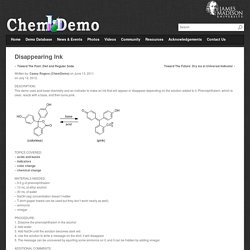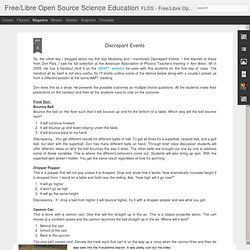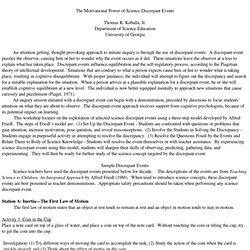Zoom
Trash

91405. Chemistry Demonstrations. Written by: Casey Rogers (ChemDemo) on June 13, 2011.on July 12, 2012.

DESCRIPTION: This demo uses acid base chemistry and an indicator to make an ink that will appear or disappear depending on the solution added to it. Phenolphthalein, which is clear, reacts with a base, and then turns pink. TOPICS COVERED:– acids and bases – indicators – color change – chemical change MATERIALS NEEDED:– 0.5 g of phenolphthalein – 10 mL of ethyl alcohol – 30 mL of water – NaOH (aq) concentration doesn’t matter – T-shirt (paper towels can be used but they don’t work nearly as well) – ammonia – vinegar PROCEDURE:1. ADDITIONAL COMMENTS:This demo could be used in a CSI themed demo day.
SAFETY: Safety goggles should be worn at all times. REFERENCES:Shakhashiri, B.Z. General Chemistry Demonstrations. This Is What Happens When You Mix Coca-Cola And Milk. What happens when you mix Coca-Cola and milk?

This, apparently: In this fascinating YouTube video, watch what happens when milk is added to a bottle of Coke. After an hour, the liquid in the bottle appears to become clear, as brown sediment sinks to the bottom. So how exactly is this “invisible soda” created? Per the blog of Steve Spangler Science, a science gadgets and experiments website: The separation happens because of a reaction between phosphoric acid and milk. The video of the experiment was first posted on YouTube in January, but has experienced a viral resurgence this week.
H/T Viral Viral Videos. Chemical misconceptions II - Chemical comparisons- Learn Chemistry. Intro & Contents: IBDP Chemistry Discrepant Events. February 7th, 2013 While what I do with my students is described below, any IBDP chemistry student may find these discrepant events useful.

Often at the beginning of a topic, students will either observe a demonstration or watch a video or be given a description of a discrepant event. After sufficient materials have been covered, they are challenged to explain it. However, unlike in MYP science, their write-ups aren’t always graded. Some times the discrepant event write-up may be graded and contribute towards their final grade just as a quiz would. What a given Discrepant Event requires is made clear at the time it is demonstrated.
IB Diploma Chemistry discrepant events are labeled with either the prefix DP1 or DP2 which refer to first year and second year respectively. The Unconventional Teacher. It’s been almost 6 months now since I’ve taught a seated, in-person class (wow, Baby Teach is really growing fast!)

And MAN do I miss seeing students’ faces as we experiment with new science concepts! I’ve been thinking lately about some of my favorite science demonstrations, so I figured I would share some of my top choices with my top readers (yes, that’s you, silly!). Without further ado (and in no particular order)… 1. Microwave Soap I use this when teaching states of matter and the difference between chemical and physical change, but you can also use this with Charles’ Law (the volume of a gas increases with its temperature). Materials needed: One bar of Ivory soap (ONLY Ivory will work), one plate (paper is fine), paper towels, microwave.
Quick side note: Your microwave will smell soapy and fresh for a few hours after this experiment, but it won’t hurt anything and is not toxic. Why it works: Ivory soap is whipped during processing, which traps bubbles. 2. Small version Big version 3. Pdf/PoS/DiscrepantExplanationsCatalyst2011.pdf. Physical Science. AAPT 2009 Handouts - DMAPT. Free/Libre Open Source Science Education: Discrepant Events. So, the other day I blogged about my first day Modeling and I mentioned Discrepant Events.

I first learned of these from Don Pata. I saw his full collection at the American Association of Physics Teachers meeting in Ann Arbor, MI in 2009. He has a handout (find it on the DMAPT website) he uses with this students on the first day of class. The handout all by itself is not very useful. So I'll briefly outline some of the demos below along with a couple I picked up from a different session at the same AAPT meeting. Don does this as a show. From Don:Bouncy Ball: Bounce the ball on the floor such that it will bounce up and hit the bottom of a table. It will continue forwardIt will bounce up and down staying under the tableIt will bounce back to my handDiscrepancy - You get different results for different types of ball.
Science Experiments & Demonstrations. The Motivational Power of Science Discrepant Events. The Motivational Power of Science Discrepant Events Thomas R.

Koballa, Jr. Department of Science Education University of Georgia An attention getting, thought-provoking approach to initiate inquiry is through the use of discrepant events. An inquiry session initiated with a discrepant event can begin with a demonstration, preceded by directions to focus students’ attention on what they are about to observe. This workshop focuses on the exploration of selected science discrepant events using a three-step model developed by Alfred Friedl. Sample Discrepant Events Science teachers have used the discrepant events presented below for decade. Station A: Inertia—The First Law of Motion The first law of motion states that an object at rest tends to remain at rest and an object in motion tends to stay in motion. Activity 1: Coin in the Cup.